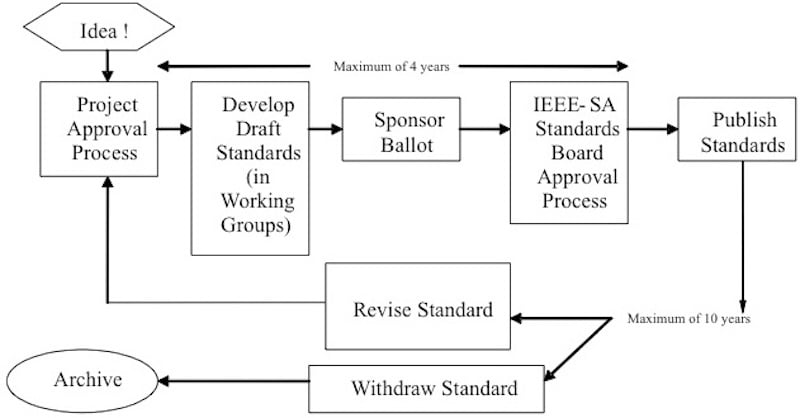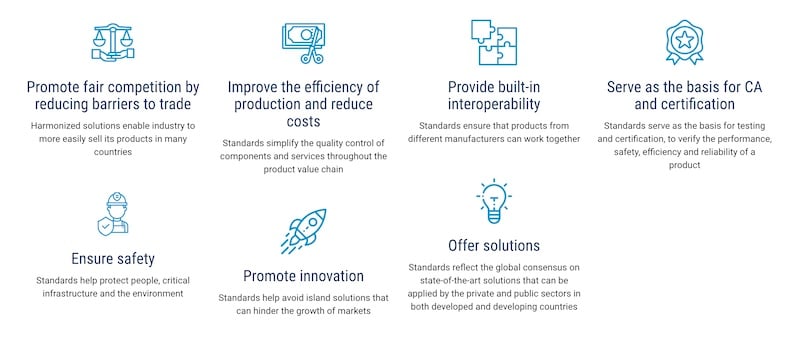To put standards into a general context, let’s say you are starting a new job as a design engineer, and someone mentions standards. What do they mean?
Well, it typically means, to name a few, publications on:
- Product performance requirements
- Product safety
- Electromagnetic compatibility (EMC)
- Interfacing with other products (think Bluetooth and USB)
There are also standards that apply to whole systems rather than individual products.
Engineering Standards Overview: Conformity vs Compliance
Standards are published by the Standardization Management Board (SMB), which includes the International Electrotechnical Commission (IEC) and, in Europe, the European Committee for Electrotechnical Standardization (CENELEC). There are also national standards, such as ANSI standards, and industry standards, such as UL and NEC. For information on how IEC approaches the creation of standards, you can visit here to learn more specifics.
Below in Figure 1, you can see a high-level example of how standards are created by the IEEE’s Standards Association.

Figure 1. A high-level diagram of how standards are created. Image used courtesy of IEEE SA
The first thing to know is that conformity to standards should be part of your design process. You do not typically ‘finish’ a design and then hand it over to safety and EMC specialists to deal with conformity. You will almost certainly have to redesign the product to make it safe and control its EM emissions and immunity, with a substantial loss of time and money. Instead, you should talk to these specialists throughout the design process. Then, when they evaluate the finished product, it will meet all the requirements.
As a note, there are two special words, conformity and compliance. The rule is that products conform to standards, and manufacturers comply with legal or market requirements.
Where Do Standards Come Into Play? Three Example Scenarios
There are three situations that can be considered:
Scenario 1
You are designing a type of product that is well-established in the market. In this case, your manager should tell you which standards apply. However, you might want to be a bit careful; standards are may go out of date. You may be told that IEC 69999-9:2012 applies, but your manager hasn’t noticed that a much-changed new edition was published last week.
Scenario 2
You are designing a new type of product. In this case, you may have to search for which standards apply on the websites of the appropriate SMBs. Some of these are much easier to find than others. In many cases, the details of the standard are hidden behind a pay wall and must be purchased from the standards body. It never hurts to reach out and ask for assistance in getting information on the standards; as long as your question is detailed enough to attract a useful response, that is.
Scenario 3
You are designing a product using emergent technology (such as the proverbial Wednesday detector for a time machine). In this case, there might be doubt about which safety and EMC standards apply, and what performance the market requires.
In this case, your company should consider proposing new standards and participating in their development. This can be a safeguard (Figure 2) against the activities of your competitor, i.e., Evil Intentions. Inc., which will try to exclude your new product from the market by setting standards you can only meet at a high cost.

Figure 2. Examples of how standards can be beneficial. Screenshot used courtesy of the IEC
Where to Find Engineering Standards
In days gone by, when it came to information on these standards, they were often hard copies in a locked filing cabinet in the CTO’s office, because they were not low-cost items. Clearly, they were not of much use there, and unfortunately, that bad practice isn’t totally extinct. But now, your company can get them on terms that allow everyone who needs them to have read-only access on their computer. They need careful study; the writers, who are engineering people just like you and me, do their best to make them as lucid as possible, but some concepts (such as measurement uncertainty) do get rather complicated.
Having chosen the applicable standard, you should read it carefully several times. Don’t be afraid to ask questions about parts you are uncertain about. Everyone runs into that issue, and it’s far riskier to assume or guess about an uncertain meaning.
What Does Applying an Engineering Standard Mean?
It depends very much on what sort of standard it is. Safety standards are usually fairly explicit on what is required. Most simply say ‘do this,’ but a few, such as IEC 62368-1 and EN 62368-1, are of a new type called hazard-based, which encourages an analytic approach to determine requirements.
As a note, IEC and CENELEC EN standards with the same number may range from almost identical to mostly the same but significantly different. CENELEC standards numbered 50xxx can be considered ‘homemade,’ while those numbered 55xxx (EMC standards) or 6xxxx are based on IEC standards.
It is a general principle of standardization that requirements can be set, in descending order of desirability:
- Requirements for performance
- Requirements for design
- Requirements for construction
The requirements for design or construction can often greatly hamper the adoption of novel approaches. On the other hand, requirements for performance are often minimum requirements for performance, so manufacturers offering better performance at higher prices often have to explain the advantages.
Additionally, EMC standards tend to be divided into four kinds:
- Basic, which specifies test and measurement procedures
- Product, which applies to a specific product type
- Product-family, which applies to products that share characteristics, such as household appliances
- Generic, applying to products that do not have a product or product-family standards
Note: Tests attract a ‘PASS’ or ‘FAIL’ outcome; the outcome of a measurement is one or more (maybe many more) numbers.
For design, you need to know what tests and measurements are required and, in principle, how they are carried out. However, you don’t need as much detailed knowledge as the specialists need, much of which is like lore—acquired by experience.
Unlike safety standards, for which there are very few guidebooks about how to implement them, there are many books about designing for EMC conformity. A few are listed in this article’s bibliography. It is always advisable to check whether there is a later edition than the one listed.
Overall, product performance standards are where the designer doesn’t often have to refer to specialists, but can exercise their ingenuity to do more and, as a basic principle of engineering: do more for less money.
Bibliography:
- Paul, Clayton R., ‘Introduction to Electromagnetic Compatibility’ ISBN-13: 978-0-47175500-5
- You can be sure that ‘Introduction’ means a very complete treatment of the subject. A Third Edition is due to be published in September 2022
- Ott, Henry W., ‘Noise Reduction Techniques in electronic systems’ ISBN-10: 0-471-85068-3
- This includes internally generated noise, thermal, shot, and others, as well as EMC-related noise.
- André Patrick G. and Wyatt K., ‘EMI Troubleshooting Cookbook for Product Designers’, ISBN-13: 978-1-61353-019-1
- Very practical, with many ongoing references.
- Williams, Tim, ‘EMC for Product Designers’, ISBN-13: 978-0081010167
- Comprehensive, with a large bibliography.
- Armstrong, Keith, ‘EMC for Printed Circuit Boards’, ISBN-13978-0-9555118-13
- A4 size pages; excellent graphics and clear text.

